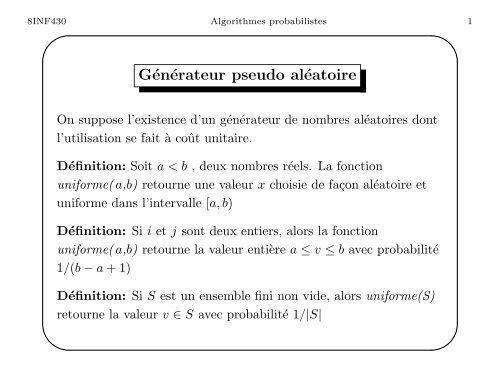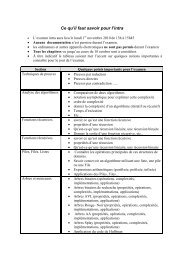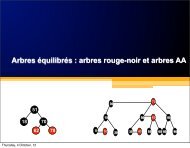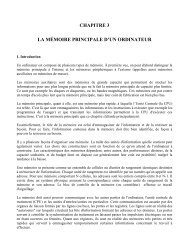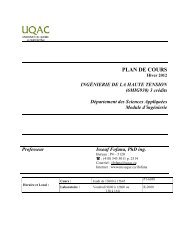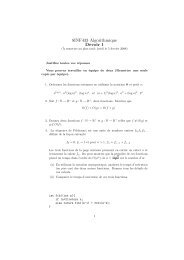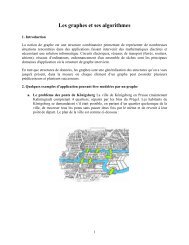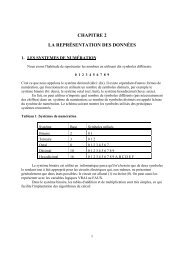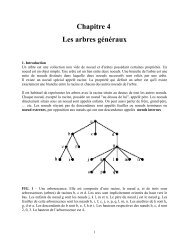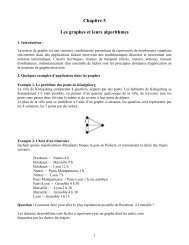Algorithmes numériques et de Sherwood - UQAC
Algorithmes numériques et de Sherwood - UQAC
Algorithmes numériques et de Sherwood - UQAC
You also want an ePaper? Increase the reach of your titles
YUMPU automatically turns print PDFs into web optimized ePapers that Google loves.
8INF430 <strong>Algorithmes</strong> probabilistes 1<br />
✬<br />
✩<br />
Générateur pseudo aléatoire<br />
On suppose l’existence d’un générateur <strong>de</strong> nombres aléatoires dont<br />
l’utilisation se fait à coût unitaire.<br />
Définition: Soit a < b , <strong>de</strong>ux nombres réels. La fonction<br />
uniforme( a,b) r<strong>et</strong>ourne une valeur x choisie <strong>de</strong> façon aléatoire <strong>et</strong><br />
uniforme dans l’intervalle [a, b)<br />
Définition: Si i <strong>et</strong> j sont <strong>de</strong>ux entiers, alors la fonction<br />
uniforme( a,b) r<strong>et</strong>ourne la valeur entière a ≤ v ≤ b avec probabilité<br />
1/(b − a + 1)<br />
Définition: Si S est un ensemble fini non vi<strong>de</strong>, alors uniforme(S)<br />
r<strong>et</strong>ourne la valeur v ∈ S avec probabilité 1/|S|<br />
✫<br />
✪
8INF430 <strong>Algorithmes</strong> probabilistes 2<br />
✬<br />
Dans les années 50: Certains ordinateurs possè<strong>de</strong>nt <strong>de</strong>s dispositifs<br />
apparemment aléatoires:<br />
• compteur <strong>de</strong> particules cosmiques<br />
• bit le moins significatif <strong>de</strong> l’horloge<br />
Impopulaire car il <strong>de</strong>vient impossible <strong>de</strong> répéter l’exécution d’un<br />
calcul:<br />
• Programme plus difficile à déboguer<br />
• Comparaison <strong>de</strong> programmes plus difficile<br />
Pour certaines applications le vrai hasard est important:<br />
• loteries<br />
• cryptographie<br />
✩<br />
En pratique, on utilise <strong>de</strong>s générateur <strong>de</strong> nombres pseudo-aléatoires.<br />
✫<br />
✪
8INF430 <strong>Algorithmes</strong> probabilistes 3<br />
✬<br />
Définition: Une séquence <strong>de</strong> nombres est dite pseudo-aléatoire si<br />
elle est générée <strong>de</strong> façon déterministe mais semble avoir été<br />
produite <strong>de</strong> façon purement aléatoire (passe avec succès certains<br />
tests statistiques).<br />
Exemple: [Métho<strong>de</strong> linéaire congruentielle]<br />
Choisir minutieusement 4 nombres:<br />
1. m: le modulo ( m > 0)<br />
2. a: le multiplicateur ( 0 ≤ a < m)<br />
3. c: le saut ( 0 ≤ c < m)<br />
4. X 0 : la valeur <strong>de</strong> départ ( 0 ≤ X 0 < m)<br />
✩<br />
La séquence <strong>de</strong> nombre pseudo-aléatoire est:<br />
✫<br />
X n+1 = (aX n + c) mod m<br />
✪
8INF430 <strong>Algorithmes</strong> probabilistes 4<br />
✬<br />
✩<br />
Implémentation <strong>de</strong> la fonction rand()<br />
Borland C++: X n+1 = (22695477 ∗ X n + 1) mod 2 32<br />
GNU gcc: X n+1 = (69069 ∗ X n + 5) mod 2 32<br />
Visual C++: X n+1 = (134775813 ∗ X n + 1) mod 2 32<br />
Apple CarbonLib: X n+1 = (16807 ∗ X n ) mod 2 31 − 1<br />
Autres métho<strong>de</strong>s: Mersenne Twister, Blum Blum Shub, <strong>et</strong>c.<br />
✫<br />
✪
8INF430 <strong>Algorithmes</strong> probabilistes 5<br />
✬<br />
✩<br />
Fait: La caractéristique fondamentale d’un algorithme probabiliste<br />
est qu’il peut se comporter différemment lorsqu’appelé <strong>de</strong>ux fois<br />
avec les mêmes paramètres.<br />
Définition: Le temps d’exécution espéré d’un algorithme<br />
probabiliste est le temps moyen <strong>de</strong> l’algorithme sur une entrée<br />
donnée.<br />
Remarque: Ne pas confondre temps espéré <strong>et</strong> temps moyen.<br />
Exemple: Quicksort prend un temps O(n 2 ) en pire cas <strong>et</strong><br />
O(n lg n) en moyenne.<br />
Si au début <strong>de</strong> l’algorithme, on permute aléatoirement les<br />
éléments du tableau. Cela peut se faire en temps O(n)<br />
Quelque soit l’entrée initiale, le temps espéré est O(n + n lg n).<br />
✫<br />
✪
8INF430 <strong>Algorithmes</strong> probabilistes 6<br />
✬<br />
Classification <strong>de</strong>s algorithmes probabilistes<br />
✩<br />
<strong>Algorithmes</strong> numériques:<br />
• Utilisé pour approximer la solution à <strong>de</strong>s problèmes numériques<br />
(ex. calculer π, intégration numérique, <strong>et</strong>c.).<br />
• La précision augmente avec le temps disponible.<br />
<strong>Algorithmes</strong> <strong>de</strong> <strong>Sherwood</strong>:<br />
• Utilisé lorsqu’un algorithme déterministe fonctionne plus<br />
rapi<strong>de</strong>ment en moyenne qu’en pire cas.<br />
• Ces algorimes peuvent éliminer la différence entre bonnes <strong>et</strong><br />
mauvaises entrées.<br />
• Exemple: quicksort<br />
✫<br />
✪
8INF430 <strong>Algorithmes</strong> probabilistes 7<br />
✬<br />
✩<br />
<strong>Algorithmes</strong> <strong>de</strong> Las Vegas:<br />
• Ces algorithmes peuvent quelque fois r<strong>et</strong>ourner un message<br />
disant qu’ils n’ont pas pu trouver la réponse.<br />
• La probabilité d’un echec peut être rendu arbitrairement p<strong>et</strong>ite<br />
en répétant l’algorithme suffisamment souvent.<br />
<strong>Algorithmes</strong> <strong>de</strong> Monte Carlo:<br />
• Ces algorithmes r<strong>et</strong>ournent toujours une réponse mais celle-ci<br />
n’est pas toujours juste.<br />
• La probabilité d’obtenir une réponse correcte augmente avec le<br />
temps disponible.<br />
✫<br />
✪
8INF430 <strong>Algorithmes</strong> probabilistes 8<br />
✬<br />
✩<br />
<strong>Algorithmes</strong> numériques<br />
• Calcul <strong>de</strong> π<br />
• Calcul d’une intégrale définie<br />
• Comptage probabiliste<br />
✫<br />
✪
8INF430 <strong>Algorithmes</strong> probabilistes 9<br />
✬<br />
✩<br />
Calcul <strong>de</strong> π<br />
L’expérience <strong>de</strong> Georges Louis Leclerc, Comte <strong>de</strong> Buffon, 1777:<br />
• Aiguille <strong>de</strong> 1 cm <strong>de</strong> long<br />
• Laisser tomber l’aiguille sur le sol<br />
• Sol recouvert <strong>de</strong> planches <strong>de</strong> 2cm <strong>de</strong> large<br />
Quelle est la probabilité que l’aiguille touche <strong>de</strong>ux planches?<br />
✫<br />
✪
8INF430 <strong>Algorithmes</strong> probabilistes 10<br />
✬<br />
✩<br />
Réponse: 1/π<br />
Si on laisse tomber n aiguilles alors l’espérance du nombre<br />
d’aiguilles qui touchent <strong>de</strong>ux planches est n/π. Cela donne<br />
l’algorithme suivant:<br />
k=0<br />
pour i=1 à n faire<br />
laisser tomber une aiguille sur le sol<br />
si l’aiguille touche 2 planches alors k=k+1<br />
r<strong>et</strong>ourner n/k (puisque E[k]=n/ π)<br />
✫<br />
✪
8INF430 <strong>Algorithmes</strong> probabilistes 11<br />
✬<br />
Comptage probabiliste<br />
✩<br />
On veut compter le nombre <strong>de</strong> truites dans un lac.<br />
On suppose qu’il est possible <strong>de</strong> pêcher <strong>de</strong>s truites (avec remise) <strong>de</strong><br />
façon aléatoire, uniforme <strong>et</strong> indépendante.<br />
On procè<strong>de</strong> <strong>de</strong> la façon suivante:<br />
répéter<br />
capturer une truite<br />
la peindre en rouge<br />
la rem<strong>et</strong>tre dans le lac<br />
jusqu’à ce qu’on recapture une truite rouge<br />
Combien <strong>de</strong> fois faut-il répéter?<br />
✫<br />
✪
8INF430 <strong>Algorithmes</strong> probabilistes 12<br />
✬<br />
✩<br />
Soit P n,k la probabilité d’avoir une répétition lorsqu’on choisit k<br />
éléments parmi n.<br />
Fait: P n,k ≈ 1 − e −k2 /2n<br />
P n,k ≈ 1 − e −k2 /2n ≥ 1/2 ⇔ e −k2 /2n ≤ 1/2<br />
⇔ −k 2 /2n ≤ ln(1/2)<br />
⇔ k 2 /2n ≥ ln(2)<br />
⇔ k ≥ √ 2 ln(2) √ n<br />
Remarque: Cela indique qu’après avoir choisi k = ⌈1.177 √ n⌉<br />
éléments, la probabilité d’avoir une répétition dépasse 50%.<br />
Fait: Lorsque n → ∞ on a E(k) = √ πn/2 <strong>et</strong> E(k 2 ) = 2n<br />
✫<br />
✪
8INF430 <strong>Algorithmes</strong> probabilistes 13<br />
✬<br />
✩<br />
Fait: Lorsque n → ∞ on a E(k) = √ πn/2 <strong>et</strong> E(k 2 ) = 2n<br />
fonction compter(S)<br />
k = 0<br />
T = ∅<br />
a=uniforme(S)<br />
Tantque a /∈ T faire<br />
k = k + 1<br />
T = T ∪ {a}<br />
a=uniforme(S)<br />
r<strong>et</strong>ourner k 2 /2<br />
✫<br />
✪
8INF430 <strong>Algorithmes</strong> probabilistes 14<br />
✬<br />
✩<br />
<strong>Algorithmes</strong> <strong>de</strong> <strong>Sherwood</strong><br />
Exemple: Quicksort:<br />
procédure Pquicksort(T[1..n])<br />
mélanger(T[1..n])<br />
quicksort(T[1..n])<br />
procédure mélanger(T[1..n])<br />
pour i=1 à n-1 faire<br />
j=uniform(i,n)<br />
échanger T[i] <strong>et</strong> T[j]<br />
Temps espéré: O(n + n lg n) = O(n lg n)<br />
✫<br />
✪
8INF430 <strong>Algorithmes</strong> probabilistes 15<br />
✬<br />
✩<br />
Hachage universel<br />
On veut m<strong>et</strong>tre en mémoire un p<strong>et</strong>it nombre d’éléments (disons n)<br />
provenant d’un grand ensemble X.<br />
Exemple: Table <strong>de</strong>s symboles d’un compilateur, mémorisation<br />
d’adresses IP, <strong>et</strong>c.<br />
On veut un accès très rapi<strong>de</strong> à ces éléments: O(1)<br />
Adressage direct: Espace O(|X|).<br />
Liste chaînée: Temps <strong>de</strong> recherche O(n).<br />
Table <strong>de</strong> hachage: Espace O(n), temps <strong>de</strong> recherche O(?)<br />
✫<br />
✪
8INF430 <strong>Algorithmes</strong> probabilistes 16<br />
✬<br />
✩<br />
Fonction <strong>de</strong> hachage<br />
Définition: Soit N > 0. Une fonction <strong>de</strong> hachage est une fonction<br />
<strong>de</strong> la forme<br />
Exemple: h(k) = k MOD N<br />
h : X → {0, 1, ..., N − 1}<br />
Définition: Une collision se produit lorsque a ≠ b <strong>et</strong> h(a) = h(b).<br />
Une solution pour résoudre ce problème consiste à utiliser une table<br />
<strong>de</strong> listes.<br />
Fait: Si a <strong>et</strong> b sont choisit <strong>de</strong> façon aléatoire <strong>et</strong> uniforme dans X<br />
alors la probabilité d’une collision est 1/N.<br />
✫<br />
✪
8INF430 <strong>Algorithmes</strong> probabilistes 17<br />
✬<br />
✩<br />
Fait: Aucune fonction <strong>de</strong> hachage n’est parfaite.<br />
Idée: La fonction <strong>de</strong> hachage n’est pas fixé mais choisit<br />
aléatoirement parmi un ensemble <strong>de</strong> fonctions.<br />
• Le nombre <strong>de</strong> fonctions f : X → {0, .., N − 1} est N |X| .<br />
• Si f est choisit <strong>de</strong> façon uniforme alors pour a ≠ b on a<br />
Pr(f(a) = f(b)) = 1 N<br />
• En pratique, il n’est pas possible <strong>de</strong> choisir aléatoirement une<br />
fonction f : X → {1, .., N} car N |X| est trop grand.<br />
On doit donc restreindre l’ensemble <strong>de</strong>s fonctions possibles.<br />
✫<br />
✪
8INF430 <strong>Algorithmes</strong> probabilistes 18<br />
✬<br />
✩<br />
Classe universelle <strong>de</strong> fonctions<br />
Soit H une classe <strong>de</strong> fonctions X → {0, .., N − 1} <strong>et</strong> soit h ∈ H une<br />
fonction dans H choisit <strong>de</strong> façon aléatoire <strong>et</strong> uniforme.<br />
Alors H est une classe universelle <strong>de</strong> fonctions si pour tout a ≠ b<br />
dans X on a:<br />
Pr(h(a) = h(b)) = 1 n<br />
✫<br />
✪
8INF430 <strong>Algorithmes</strong> probabilistes 19<br />
✬<br />
✩<br />
Exemple 1<br />
Un certain service Web nécessite <strong>de</strong> mémoriser l’adresse IP <strong>de</strong>s<br />
client actifs.<br />
• X est l’ensemble <strong>de</strong> toutes les adresses IP possibles<br />
• Chaque adresse x ∈ X est <strong>de</strong> la forme x = (x 1 , x 2 , x 3 , x 4 ) où les<br />
x i ont 8 bits (ex. x = 132.212.11.75 )<br />
• On utilise une table <strong>de</strong> hachage <strong>de</strong> n = 257 entrées<br />
(n peut être n’importe quel nombre premier).<br />
✫<br />
✪
8INF430 <strong>Algorithmes</strong> probabilistes 20<br />
✬<br />
✩<br />
On choisit les paramètres suivants:<br />
• a = (a 1 , a 2 , a 3 , a 4 ) ∈ {0, . . . , n − 1} 4<br />
• h a : X → {0, . . . , n − 1}<br />
• h a (x) = (a 1 x 1 + a 2 x 2 + a 3 x 3 + a 4 x 4 ) mod n<br />
• H = {h a | a ∈ {0, . . . , n − 1} 4 }<br />
Fait: H est une classe universelle <strong>de</strong> fonctions<br />
✫<br />
✪
8INF430 <strong>Algorithmes</strong> probabilistes 21<br />
✬<br />
✩<br />
Preuve: On doit montrer que si x ≠ y sont <strong>de</strong>ux éléments <strong>de</strong> X<br />
alors<br />
Pr(h a (x) = h a (y)) = 1 n<br />
Supposons que x 4 ≠ y 4 <strong>et</strong> que h a (x) = h a (y). On a<br />
3∑<br />
a i (x i − y i ) = a 4 (y 4 − x 4 ) (mod n)<br />
i=1<br />
Si la partie <strong>de</strong> gauche vaut c alors on doit avoir<br />
a 4 = c(y 4 − x 4 ) −1<br />
La probabilité que cela se produise est 1/n<br />
✫<br />
✪
8INF430 <strong>Algorithmes</strong> probabilistes 22<br />
✬<br />
✩<br />
Exemple 2<br />
On défini h m,n : X → {0, 1, .., N − 1} <strong>de</strong> la façon suivante:<br />
• p > |X|, un nombre premier<br />
• m <strong>et</strong> n, <strong>de</strong>ux entiers < p<br />
• h m,n (x) = (mx + n mod p) mod N<br />
H = {h n,m | m, n < p}<br />
Fait: H est une classe universelle <strong>de</strong> fonctions<br />
✫<br />
✪
8INF430 <strong>Algorithmes</strong> probabilistes 23<br />
✬<br />
✩<br />
Preuve: Soit x, y ∈ X tels que x ≠ y.<br />
Question: Combien y a-t-il <strong>de</strong> fonctions dans H telles que<br />
h(x) = h(y)?<br />
Réponse: il y a au plus p(p−1)<br />
N<br />
n.<br />
1. ≤ p possibilités pour n<br />
choix possibles pour la paire m <strong>et</strong><br />
2. ≤ p−1<br />
N<br />
possibilités pour m<br />
✫<br />
✪
8INF430 <strong>Algorithmes</strong> probabilistes 24<br />
✬<br />
✩<br />
1.<br />
h(x) = h(y)<br />
(mx + n mod p) mod N = (my + n mod p) mod N<br />
(m(x − y) mod p) mod N = 0<br />
=⇒ p possibilités pour n<br />
✫<br />
✪
8INF430 <strong>Algorithmes</strong> probabilistes 25<br />
✬<br />
✩<br />
2.<br />
Puisque 1 ≤ m < p <strong>et</strong> 0 ≤ x, y < |X| − 1 <strong>et</strong> x ≠ y alors<br />
m(x − y) mod p ≠ 0<br />
m(x − y) = ap + b où 0 < b < p<br />
(m(x − y) mod p) mod N = b mod N = 0<br />
On a donc b ∈ {N, 2N, · · · , ⌊ p−1<br />
N<br />
⌋N}<br />
Fait: Pour chaque b il y a exactement une valeur <strong>de</strong> m telle que<br />
m(x − y) mod p = b.<br />
=⇒ ≤ p−1<br />
N<br />
possibilités pour m<br />
✫<br />
✪
8INF430 <strong>Algorithmes</strong> probabilistes 26<br />
✬<br />
✩<br />
Il y a donc au plus p(p−1)<br />
N<br />
fonctions h ∈ H telles que h(x) = h(y).<br />
De plus, il y a p(p − 1) fonctions dans H = {h m,n | 1 ≤ m < p <strong>et</strong><br />
0 ≤ n < p}.<br />
La probalilité d’avoir une collision est donc au plus:<br />
p(p−1)<br />
N<br />
p(p−1) = 1 N<br />
Ce qui démontre que H est une classe universelle <strong>de</strong> fonctions.<br />
✫<br />
✪
8INF430 <strong>Algorithmes</strong> probabilistes 27<br />
✬<br />
✩<br />
✫<br />
✪
8INF430 <strong>Algorithmes</strong> probabilistes 28<br />
✬<br />
✩<br />
✫<br />
✪
8INF430 <strong>Algorithmes</strong> probabilistes 29<br />
✬<br />
✩<br />
✫<br />
✪


